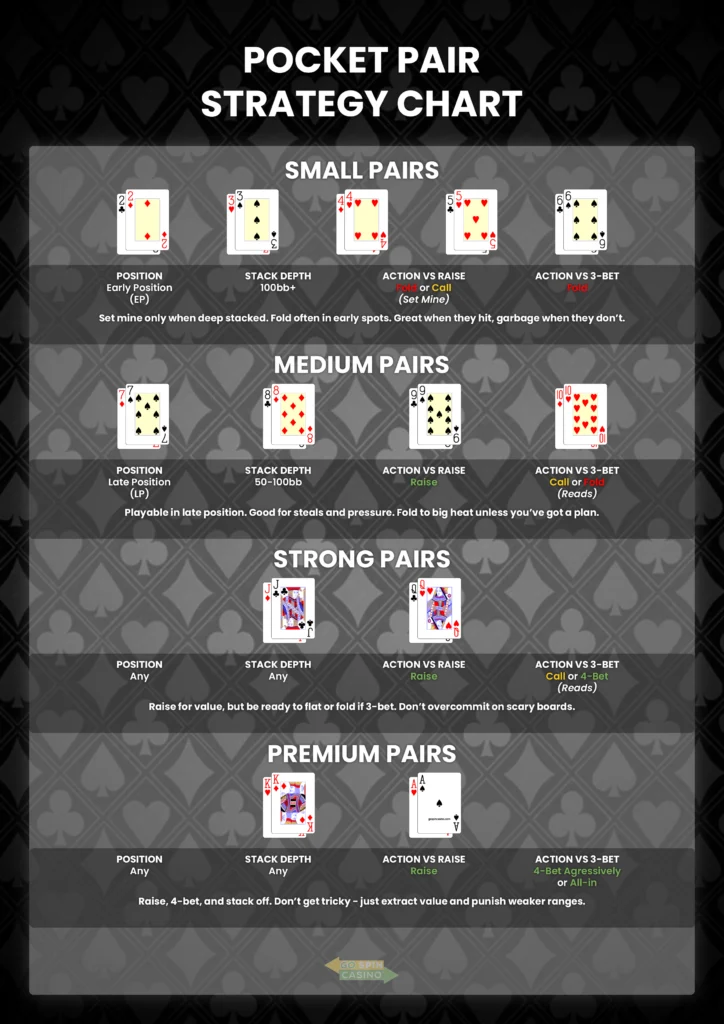You’re dealt pocket eights under the gun. What’s your next move?
Many players freeze in this spot, uncertain whether to raise, limp cautiously, or fold and wait for a premium pair. Pocket pairs feel strong but are deceptively tricky to play, causing plenty of chips to vanish from your stack when mishandled.
Play them too passively, and you’re leaving money on the table. Push them too aggressively at the wrong times, and you’re lighting your stack on fire. Chase flops blindly for sets, and you’ll steadily bleed your bankroll dry.
But mastering pocket pairs gives you a powerful weapon in both cash games and deep tournament runs. Whether you’re grinding low-stakes tables online or battling seasoned pros live, turning your pocket pairs into consistent profit separates winning players from recreational hopefuls.
This guide clears up confusion, breaks down precise odds, exposes common traps, and gives you actionable strategies, from playing cautious deuces to extracting max value from aces.
Here’s exactly how to win more often and bigger when you’re dealt a pocket pair.
Table of contents
- What Is a Pocket Pair in Poker?
- Odds of Getting and Hitting with Pocket Pairs
- How to Play Pocket Pairs Based on Strength
- Position and Stack Depth: The Real Deciders
- When to Fold a Pocket Pair (Yes, It Happens)
- Common Mistakes with Pocket Pairs
- Quick Pocket Pair Strategy Chart
- Practice Makes Perfect: Where to Try Your Pocket Pair Strategy
- FAQs About Pocket Pairs in Poker
What Is a Pocket Pair in Poker?
A pocket pair is when your two hole cards are identical in rank, think 7♠7♦, Q♣Q♥, or 2♣2♠. It’s a straightforward, powerful hand because you’re already holding a pair preflop. Ranging from the weakest (22) to the strongest (AA), pocket pairs are a cornerstone of profitable poker play, beloved when you hold them, feared when your opponent does.
Players typically categorize pocket pairs into three strategic groups:
- Small pairs: 22–66
- Medium pairs: 77–TT
- Big pairs: JJ–AA
Each category demands a different strategic approach based on position, stack depth, and opponents. For example, pocket twos are purely speculative and ideal for set mining, while pocket aces call for aggressive raises and strategic postflop play. Everything between these extremes requires nuanced judgment.
Odds of Getting and Hitting with Pocket Pairs
When you’re card-dead, pocket pairs feel scarce, but statistically, you’ll receive one every 17 hands on average, or roughly 6% of the time. Not exactly rare, but infrequent enough that waiting solely for pocket pairs will lead to overly tight, predictable play.
How Often Do You Get a Pocket Pair?
There are 13 distinct pocket pairs (22 through AA) out of a total of 1326 possible starting hands in Texas Hold’em. Crunching these numbers gives you a clear expectation:
- Probability of receiving any pocket pair: Approximately 6% (1 in 17 hands).
This frequency is significant over the course of a session, but not something you should count on exclusively.
Odds of Hitting a Set or Better
Suppose you’re dealt 5♠5♦. What are your actual odds of improving?
- Flopping a set: About 12% (1 in 8 hands)
- Completing a set by the river (if you see all 5 cards): Approximately 20%
- Flopping a full house: Around 0.73%
- Flopping quads: Only 0.25%
The chance of hitting a set or better is appealing but carries a crucial catch: implied odds. Simply hitting your set isn’t enough, you must also ensure you’ll get paid off when you do.
Do Pocket Pairs Win Often?
It depends heavily on how and when you play them, and what your opponents hold.
Take pocket twos (2♠2♥) against a common hand like A♦K♦ preflop:
- Pocket 2s vs. AK offsuit: Approximately 53% equity preflop.
This advantage quickly disappears if overcards hit the board (which frequently happens). With bigger pairs (QQ+), you’re more likely to win by applying aggression or extracting value throughout the hand. Small pairs, however, often become “set-or-fold” decisions postflop.
In short, pocket pairs are profitable when played strategically, not automatically.
How to Play Pocket Pairs Based on Strength
Not all pocket pairs are created equal. While deuces and aces both involve matching hole cards, their strategic roles couldn’t be more different once betting begins. Playing pocket pairs profitably requires adjusting your approach based on strength, position, stack depth, and opponent tendencies.
Here’s your quick strategic guide broken down clearly:
Small Pocket Pairs (22–66)
These hands are ideal for set mining, but only under the right conditions.
General rule: You should have at least 20x the raise size behind to make set mining worthwhile. Why? Because your chances of hitting a set are about 1 in 8, meaning you must be confident you’ll get paid enough when you connect.
Good spots to play small pairs:
- In position against loose or aggressive openers.
- Multiway pots offering excellent odds.
- Deep-stacked cash games (100bb+ effective stacks).
Avoid playing small pairs when:
- You’re out of position without initiative.
- Facing large 3-bets, especially from tight players.
- Short-stacked situations or late-stage tournaments with shallow stacks.
Don’t call raises just hoping you’ll “get lucky”, implied odds are essential. Without them, small pocket pairs quickly turn into losing propositions.
Medium Pocket Pairs (77–TT)
Medium pairs are tricky, the “grey zone” of pocket pairs. They’re too strong to fold automatically yet too vulnerable for big pots without proper context.
Ideal scenarios for medium pairs:
- Opening or isolating from late positions (especially BTN or CO).
- Flatting smaller raises in position against weaker opponents.
- Selectively squeezing against tight players behind you.
Postflop is where medium pairs often become problematic. You’re likely to face one or two overcards, leaving your hand in uncertain territory. Decision-making hinges on:
- Opponent reads (tight vs. aggressive).
- Flop texture (connected boards vs. dry flops).
- Stack depth (deeper stacks offer more maneuverability).
Example scenario: Holding 99 in the hijack facing an early position 3-bet usually calls for folding or careful flatting only if stacks are deep and your opponent’s range justifies the call. On the button facing passive blinds, fire away confidently.
Big Pocket Pairs (JJ–AA)
Here’s where pocket pairs become premium hands, built for aggression and value extraction.
Key mindset:
- JJ: Powerful yet vulnerable, particularly when flops bring overcards. Manage cautiously but assertively.
- QQ: Dominant in most scenarios; however, remain prepared to lay down facing intense pressure from tight ranges.
- KK & AA: Strongest preflop hands, ideal for aggressively building pots. But avoid huge raises (like 6x opens) that discourage action unless you’re facing a wild table.
Common mistake alert: underplaying or overplaying big pairs. Limping or just calling with AA/KK means leaving value behind. Conversely, excessively large preflop raises scare off weaker hands and shrink your profitability.
Instead, aim for balanced aggression:
- Adjust raise sizing to suit your table dynamics.
- Target loose or calling-station opponents who’ll pay you off.
- Maintain awareness of player tendencies for extracting maximum value.
Position and Stack Depth: The Real Deciders
The €/$ 10 Martingale Scenario
If you’re serious about profiting from pocket pairs, position and stack depth are your lifelines. Ignoring either factor is a recipe for leaks and missed opportunities. Here’s exactly how to leverage both for consistent profits:
Stack Depth: Why 100bb+ Changes Everything
Deep stacks (100bb or more) offer you plenty of room for strategic moves, making speculative plays like set mining highly profitable with small-to-medium pairs.
- With deep stacks (100bb+): You can comfortably call preflop raises to see cheap flops. If you spike a set, there’s plenty of money behind to reward your patience.
- With shorter stacks (20–30bb): Implied odds vanish. Jam-or-fold ranges take priority.
Here’s how shorter stacks impact your pocket pair strategy:
- 22–66: Usually a fold unless you can shove profitably against short-stacked openers.
- 77–TT: Good candidates to jam over late-position opens, or cautiously flat if your stack and position allow.
- JJ+: Frequently strong enough to confidently shove preflop, depending on ICM and opponent ranges.
Bottom line: Depth dictates your strategy, deep means patience, short means decisiveness.
Position: Where You Sit Makes All the Difference
The strategic value of a pocket pair shifts dramatically depending on where you sit at the table. Consider pocket eights (88) as an example:
- Under the Gun (UTG): You act first, facing the tightest ranges and potential strong 3-bets. Here, 88 becomes a cautious open at best.
- Cutoff (CO) or Button (BTN): Late positions amplify fold equity and information. You can open more aggressively, putting opponents on defense.
Simply put, late position gives you more flexibility and power, especially with pairs that rarely improve postflop.
Real-World Example: Big Blind vs. Button Raise
Imagine you’re holding 55 in the big blind, and the button, a semi-aggressive regular, raises to 2.5x. How do you respond?
Quick decision checklist:
- Stack depth: If both of you have around 100bb, calling to set mine is generally profitable, particularly against opponents who frequently continuation bet (c-bet).
- Position disadvantage: You’ll play postflop out of position, making it tougher if you miss.
- Opponent tendencies: Does this player fold to frequent 3-bets? If yes, consider an occasional 3-bet bluff with 55, but proceed cautiously.
- Antes or extra money in the pot? Improved pot odds make calling more attractive.
Default recommended play: Call to set mine, but be prepared to let go quickly if the flop misses you and you face aggression.
Remember: Position and stack size aren’t optional considerations, they’re your compass for profitable play with pocket pairs.
When to Fold a Pocket Pair (Yes, It Happens)
Let’s bust a common poker myth: holding a pocket pair doesn’t automatically mean you have to see the flop. Folding pocket pairs in marginal spots is actually one of the best ways to protect your bankroll and ensure long-term profitability.
Knowing when to let go is just as crucial as knowing when to raise. Here are three clear-cut scenarios where folding pocket pairs is typically your smartest play:
1. Facing Big 3-Bets or 4-Bets with Small Pairs
Imagine you’re in middle position holding 44. You open to 2.2x, and the cutoff 3-bets aggressively to 7x. You’re both deep-stacked. Tempted to call?
Don’t. Unless your opponent regularly overplays their range or you’re extremely deep-stacked, calling here is a leak. Small pairs lose their profitability in bloated pots unless they hit a set, and in large 3-bet pots, your implied odds shrink significantly.
If you’re unsure you’ll get paid big when hitting, or disciplined enough to fold postflop, folding preflop is clearly better.
2. Short Stacks with No Implied Odds
If you’re holding a medium-to-small pair (like 66) in early position with only 20–30 big blinds, resist the temptation to play passively.
There’s simply no room for speculative set mining when short-stacked. You lack both implied odds and maneuverability postflop. Jam or fold becomes your decision, and early-position medium pairs often aren’t profitable jams.
Save your stack for clearer, stronger opportunities rather than risking it on slim chances.
3. Overcards Plus Pressure Means Let It Go
Let’s say you hold 77, call a raise preflop, and see a flop of A♣ K♦ J♠. Your opponent bets strongly. Time to call?
Almost never. Even if your opponent missed entirely, your sevens are reduced to a weak bluff-catcher. And most opponents firing into a high-card-heavy board have legitimate strength or a strong draw. Calling here bleeds your stack unnecessarily.
If you’re facing overcards and significant aggression, your pocket pair usually becomes a worthless holding. Fold quickly and confidently.
Remember: Folding Isn’t Weakness, It’s Smart Poker
The best players consistently make disciplined folds, avoiding costly battles where their equity is thin. Your long-term EV (expected value) skyrockets by preserving chips when you’re clearly behind, so you can fully leverage stronger holdings later.
Know when to fold, and your bankroll, and win rate, will thank you.
Common Mistakes with Pocket Pairs
Even seasoned poker players regularly mishandle pocket pairs, not from ignorance of odds, but from neglecting situational context. Pocket pairs aren’t automatic chip printers; they’re strategic tools. Misuse them, and they’ll cost you more than a missed flush draw.
Here are the most common leaks and how you can fix them:
Overvaluing Small Pairs
Pocket threes (33) might look appealing preflop, but calling raises recklessly, chasing multi-street bluffs, or stubbornly holding them postflop without improvement quickly drains your stack.
Small pairs are speculative hands, not premiums. They’re fantastic for flopping sets and stacking opponents, but miserable if you’re just calling raises and staring at flop textures like K-Q-9. Understand their speculative role clearly, and respect it.
Chasing Sets Without Implied Odds
Here’s a frequent beginner trap: “If I hit my set, I’ll get paid big.”
Not always. Set-mining profits depend on whether:
- You’re in position.
- Stacks are sufficiently deep (ideally 100bb+).
- Your opponent will pay you off generously if you hit.
If an opponent raises with a shallow stack (around 25bb), chasing a set isn’t profitable, it’s a clear leak. The math just doesn’t add up: you risk too much chasing minimal returns.
Playing Big Pairs Passively Postflop
Imagine holding QQ and raising preflop, getting one caller. The flop lands 9♠7♣2♦, safe, low, and disconnected. If you check-call through streets here, you’re literally giving away chips.
Big pocket pairs are built for value extraction and pot building. Passive play risks losing to draws or turning control over to aggressive opponents. You don’t need reckless barreling, but confidently bet and raise to protect your hand and maximize value when ahead.
Don’t fear phantom hands, capitalize confidently on safe boards.
Limping from Early Position
If you habitually limp with hands like 55 under the gun (UTG) to cheaply “see a flop,” you set yourself up for isolation, aggressive raises, or chaotic multiway pots.
Limping early is almost always a leak. Unless you’re exceptionally deep in a passive, recreational game, and even then it’s often suboptimal, stick to a disciplined open-raise or fold approach.
Ignoring Position and Opponent Reads
Subtle yet critical, your position and opponents dictate pocket pair play. The same pair (like 88) plays vastly different from the button compared to UTG. Similarly, calling a tight player’s premium-range 3-bet with 66 is usually a losing proposition.
Always factor in:
- Player tendencies (tight vs. loose).
- Your table position (early vs. late).
Failing to adjust your strategy based on these elements means you’re either missing value or donating chips unnecessarily.
Quick Pocket Pair Strategy Chart
When you’re in the heat of battle at the table, or juggling multiple online games, having a clear, reliable reference is invaluable. Here’s your go-to chart for confidently playing pocket pairs based on your position, stack depth, and the action you’re facing:

Key Strategy Reminders:
- Set mining (22–66) is only profitable with deep stacks (100bb+) and strong implied odds.
- Medium pairs (77–TT) shine in late position for stealing blinds and applying pressure.
- JJ–QQ require strategic decision-making, let opponent tendencies guide your flat or 4-bet.
- KK and AA: Stay aggressive; maximize immediate value. Fancy plays lose you money long-term.
This chart isn’t rigid, poker is always situational, but keep this quick-reference handy to sharpen your play and avoid costly mistakes.
Practice Makes Perfect: Where to Try Your Pocket Pair Strategy
Poker isn’t solved on paper, you sharpen your skills through real-world practice. Theory sets the foundation, but actual hands against real opponents build profitable instincts. Luckily, there are plenty of low-risk, high-value (+EV) ways to refine your pocket pair strategy without blowing your bankroll.
1. Play at Trusted Poker Sites
We partner exclusively with trusted poker platforms known for softer competition, consistent traffic, and attractive rakeback, ideal for honing tricky situations like early-position 66 or shoving 99 from late position.
Look for:
- Micro-stakes cash tables, perfect for polishing your postflop game.
- Freeroll tournaments, to practice short-stack strategy and improve ICM skills.
- Beginner-friendly Sit & Gos, ideal environments to test and adjust your ranges under pressure.
Check out our recommended poker sites for hands-on experience plus valuable, easily unlocked bonuses.
2. Track and Train with Poker Software
Wondering if you’re consistently overvaluing JJ or misinterpreting tricky flops with 88? Professional poker tools, such as tracking software (HUDs) and preflop range trainers, are essential to identify and plug leaks.
Start using:
- Free preflop charts, instantly see correct open, flat, or jam decisions by position.
- Hand replayers, study critical mistakes from your sessions and correct your approach.
- Equity calculators, understand exactly how hands like 99 vs AQ stack up on various boards.
3. Prioritize Reps Over Immediate Results
Don’t fixate solely on immediate outcomes. Even small losses during practice sessions help build the muscle memory you’ll rely on during crucial moments. Get sufficient reps across:
- Various stack sizes.
- Diverse board textures.
- Different opponent types (tight, loose, passive, aggressive).
Your goal is confidence and clarity in every scenario, no guesswork, just sharp, informed decision-making.
FAQs About Pocket Pairs in Poker
You’ll receive a pocket pair approximately once every 17 hands, that’s about 6% of the time. They’re not extremely rare, but don’t count on pocket pairs alone to make your session profitable.
When you have a pocket pair, the odds of hitting a set on the flop are roughly 12%, or about 1 in 8. Remember, set mining is profitable only when your stack is deep enough, and opponents will pay you off.
Definitely not. Whether you play your pocket pair depends heavily on your position, stack size, opponent tendencies, and the preflop action you’re facing. Strategic folding is often as important as strategic playing.
Preflop, pocket twos have about 50–55% equity against unpaired overcards like AK. Postflop, however, their strength drops quickly if overcards hit. Unless you improve to a set, pocket deuces become significantly weaker postflop.
Preflop, yes, a pocket pair always beats unpaired high cards initially. But once community cards hit the table, your pocket pair’s strength depends entirely on the board texture and the betting action. Don’t assume you’re ahead just because you started strong.












































